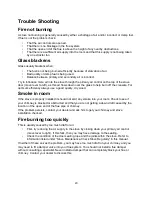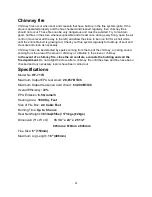
21
Chimney fire
Chimney fires occur when soot and creosote that have built up in the flue system ignite. If the
stove is operated properly and the flue checked and cleaned regularly, then chimney fires
should not occur. These fires can be very dangerous and must be avoided. Try to maintain
good, hot fires in the stove whenever possible and at least once during every firing, open the air
control (move lever all the way to the left) and allow the stove to burn on full for a short while
until the entire fire bed is glowing red. Check your flue system regularly for build-up of soot and
creosote and clean as necessary.
Chimney fires can be detected by sparks coming from the top of the chimney, a roaring sound
coming from the area of the stove or chimney or vibration in the stove or chimney.
In the event of a chimney fire, close the air controls, evacuate the building and call the
fire department.
Do not relight the stove after a chimney fire until the stove and flue have been
checked and any necessary repairs have been carried out.
Specifications
Model No:
HF-717U
Maximum Output EPA test wood:
28,857 BTU/h
Maximum Output Seasoned Cord Wood:
63,000 BTU/h
Overall Efficiency
: 72%
EPA Emission:
6.5 Grams/h
Heating Area:
1800 Sq. Feet
Size of Fire Box:
2.0 Cubic Feet
Burning Time:
Up to 8 hours
Real Net Weight:
381 lbs(±5lbs)/ 173 kgs (±2kgs)
Dimension (H x W x D):
35 1/4” x 24” x 25 1/2”
895mm x 610mm x 648mm
Flue Size:
6" (150mm)
Maximum Log Length:
16" (406mm)



































